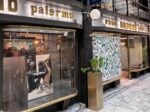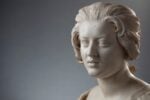Cuoghi Corsello – MCCC
.jpg)
T293 presenta una mostra-racconto che narra la sensibilità sviluppata nel lungo percorso artistico di Cuoghi Corsello, duo artistico formato da Monica Cuoghi (Mantova, 1965) e Claudio Corsello (Bologna, 1964), attivo nel capoluogo emiliano da più di trent’anni.
Comunicato stampa
T293 is happy to present a show-narration which tells the story of an approach developed over the course of Cuoghi Corsello’s artistic research. Cuoghi Corsello is an artistic duo formed by Monica Cuoghi (Mantova, 1965) and Claudio Corsello (Bologna, 1964), that has been active in the capital of Emilia for thirty years now. This artistic partnership was born in the classrooms of Bologna Academy of Fine Arts during the second half of the 80s. Drawing on the spheres of reality, music, customs and communication, the artists present an artistic-conceptual practice which is unique for the international contemporary art scene. The show in Rome is an imaginary journey towards mysterious worlds, enigmatic paths and paradoxical stories. It unfolds through a sort of a fil rouge which accompanies the spectator to the poetic world created by the artists through a combination of compositions from the past and more recent works. The narration is built on locations that have been occupied by Cuoghi Corsello during the years and which have become both home, atelier and museum for them. Occupying spaces is both an expression of an ideological concept and of artistic act of re-appropriation of the urban space, which should be taken care of and where the beauty should be cultivated.
'Spina Dorsale', 2002 is a large installation made of chairs coming from the conference room of FIAT, a third factory that has been occupied by the artists (2001 – 2005). This installation is at the core of the story. The chairs, assembled and disassembled similarly to other objects present in the spaces, form curves, patterns and angles that are different every time the installation is composed. The chairs intersect and enter in dialogue with other objects. The work 'Quadrupede divelto', 2015 represents another displacement. Following multiple detours and alterations, the work finds a new life in the gallery: it is reborn thanks to a piece of the carpet that has been torn during one of the exhibitions. The objects are animated by time, they interpret roles and adventures. By gaining density, they become more powerful and turn into silent or vocal archetypes which help compose new works. The use of objects is a necessity that the artists have had from the very beginning of their research: there is no clear distinction and separation between found objects, the commissioned ones, the artisanal ones and the artifacts. Each one has a spirit of its own which allows it to enter in dialogue with other objects. In this melting pot the artists put together objects, narrate balances and relationships through stories that must change over time in order to stay alive. 'Vestito stagionato all'aperto per 8 anni', 2014 is a dress that has been bought because of its beauty but which has never been put on. The dress has been left outside as a sort of a witness of an absence of a body, as an orphaned prosthesis of someone, and that experiences the fortuity of time and weather events.
'Pinocchio', 1996-2001 is a work that has been conceived in Cime Tempestose, the second factory occupied by the artists, and eventually was installed in FIAT, an ideal location for it, in 2001. The artwork is a small sculpture made of plastic portraying Pinocchio holding a cat, both of them shipwrecked. Situated in the middle of a playpen from the 70s with a net around it which supports the two rows fitted to the box, Pinocchio looks perplexed, both lost and hoping to survive and save the cat.
'Uncino', 2018 is the most recent work, made of broken neon tubes which have been welded together and given a new life thanks to the noble gas Argon. The past and the present, the coldness of the composition and the expressive warmth all seem to praise the same form.
Finding pieces, putting them together, giving them a new life, collecting waste and creating various settings for it – all these actions have always been essential and necessary for the poetics of Cuoghi Corsello. 'Mutandine', 2016 and 'Quadrupede astratto', 2016 are two paintings made of the hotel carpets that have been transformed in a collage. The paintings are meant to give meaning to abstract materiality of paint, emphasized through the decorations that originally had a different purpose.
Cuoghi Corsello
MCCC
16 febbraio – 14 marzo, 2019
Opening 15 febbraio 2019, 6 pm
T293 presenta una mostra-racconto che narra la sensibilità sviluppata nel lungo percorso artistico di Cuoghi Corsello, duo artistico formato da Monica Cuoghi (Mantova, 1965) e Claudio Corsello (Bologna, 1964), attivo nel capoluogo emiliano da più di trent’anni. Il loro sodalizio artistico germina tra le aule dell’Accademia delle Belle Arti di Bologna nella seconda metà degli anni ’80. Attingendo dal mondo del reale, della vita, della musica, del costume e della comunicazione, danno vita ad una pratica artistico-concettuale che costituisce un unicum nel panorama dell’arte contemporanea internazionale. La mostra a Roma è un viaggio immaginario attraverso mondi misteriosi, sentieri enigmatici e storie paradossali; si dipana come un fil rouge che accompagna lo spettatore nel poetico mondo dei due artisti attraverso la presentazione di composizioni del passato e lavori più recenti. Il racconto parte dai luoghi occupati da Cuoghi Corsello negli anni e che sono allo stesso tempo loro casa, atelier e museo, rappresentazione di un concetto ideologico, di un atto artistico di riappropriazione dello spazio della città, del quale prendersi cura e in cui coltivare la bellezza.
'Spina Dorsale', 2002 è una grande installazione di sedie della sala conferenze della FIAT, la terza delle fabbriche occupate (2001 – 2005), e rappresenta il nucleo centrale del racconto. Le sedie composte e ricomposte, come tutto il resto degli oggetti presenti nei vasti spazi, formano curve, disegni e prospettive sempre differenti, intersecandosi e a volte accomunandosi con gli altri oggetti. Altro spostamento avviene con 'Quadrupede divelto', 2015 che, dopo alcune peripezie e alterazioni, ritrova in galleria nuova vita e rinasce a partire dalla lacerazione di una parte della moquette avvenuta durante una mostra. Queste presenze si animano con il tempo interpretando ruoli e avventure e, ispessendosi, diventano più potenti, archetipi muti o parlanti che vanno a comporre lavori inediti. L'uso degli oggetti è un bisogno che gli artisti manifestano sin dal principio: non vi è una vera distinzione o separazione tra quelli trovati, quelli commissionati ad artigiani, quelli artefatti, ognuno ha uno spirito proprio che s’inserisce in dialoghi con gli altri. Nel loro crogiolo, gli oggetti raccontano equilibri e rapporti come fiabe che mutano nel tempo per rimanere vive. 'Vestito stagionato all'aperto per 8 anni', 2014, è un abito, comprato per la sua bellezza ma mai indossato, lasciato all’esterno come testimone di un'assenza corporea, protesi orfana del suo ospite che vive l’accidentalità del tempo e degli eventi meteorologici.
'Pinocchio', 1996-2001 è un’opera nata a Cime Tempestose, la seconda fabbrica occupata, che ha trovato la sistemazione ideale nel 2001 alla FIAT. Si tratta di una piccola scultura di plastica raffigurante Pinocchio che tiene in braccio un gattino, insieme naufraghi. Posto al centro di un box per bambini anni ‘70 con la rete intorno che sostiene due remi in essa incastrati, Pinocchio ha uno sguardo combattuto tra lo smarrimento e la fiducia di salvare se stesso e il gattino.
'Uncino', 2018 è lavoro più recente, formato da tubi di neon rotti, fatti saldare e rivivere con il gas nobile Argon. L’alternanza tra passato e presente, così come tra la freddezza compositiva e il calore espressivo, appaiono decantare in un'unica forma. Salvare pezzi, assemblarli, conferendo loro altra vita, prelevare lo scarto e comporre diverse scene per esso, sono da sempre azioni fondamentali e necessarie che caratterizzano la poetica dei due artisti. E così 'Mutandine', 2016 e 'Quadrupede astratto', 2016 sono due dipinti su moquette per alberghi trasformati in collage, per dare senso della materialità astratta della pittura che si posa su decorazioni pensate originariamente per altro.
Cover: Cuoghi Corsello, Uncino, 2018, assembled neon, transformers, cabling / neon assemblati, trasformatori, cavi, 54 × 206 cm



